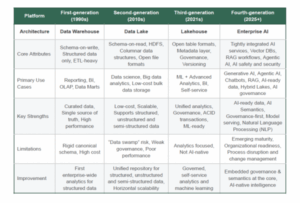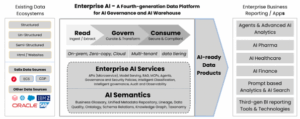
Solix Technologies today launched Enterprise AI, which it says is the industry’s first fourth-generation data platform. By integrating advanced data management capabilities into a single platform, Solix says it can deliver the clean, trusted, and governed data that enterprises need to succeed with AI.
It’s no secret that companies are struggling to find success with their AI projects, with recent studies pegging the failure rate at between 40% (Gartner) to 95% (MIT Media Lab). In many cases, the culprit for the AI woes can be traced back to one item: fragmented, siloed, dirty, poorly managed data.
“AI-ready data is the essential foundation for safe and secure enterprise AI operations,“ said James Short, Director of the SPARK AI Consortium at The San Diego Supercomputer Center. “The lack of project success reported by MIT and others can be traced largely to failures in data governance.”
Getting a data estate straightened up to support AI initiatives obviously is possible, but it’s hard work. Companies need to invest in engineering work to build processes to ensure data is cleaned, tagged, cataloged, and secured. One needs end-to-end data lineage and auditing capability, powered by metadata. Role-based access control (RBAC) policies are needed to ensure nobody is getting access to data they shouldn’t. Regional PII and data sovereignty requirements must be adhered to.

Source: Solix white paper, “Enterprise AI
A Fourth-generation Data Platform
Framework for AI Governance and AI Warehouse”
Data must be classified, and catalogs need to be kept up-to-date so analysts and scientists can search for useful data. Semantic layers must be created to ensure SQL and AI queries are getting the right data. Vector embeddings must be created and stored in a readily available repository for AI inference and retrieval-augmented generation (RAG). And all of this must be done across the entire data estate, spanning structured, semi-structured, and unstructured data, residing on-prem, in the cloud, and everywhere in between.
Third-generation data platforms provide some of these capabilities, according to Solix Technologies. Specifically, the work done around version control, caching, indexing, and advanced management of ACID transactions with Apache Iceberg and Databricks Delta helped to solve some of the data consistency issues that had bedeviled enterprises since the days of Hadoop (which is defined as a second-generation platform). First-generation data warehouses built on relational databases lack many of these capabilities.
The fourth-generation platform builds on the third-generation data lakehouses to bring all of these capabilities together, according to Solix. Instead of separately sourcing a semantic layer, a vector database, support for Model Context Protocol (MCP), RAG tooling, and an AI-powered query capability (among others), the fourth-gen data platform brings them all together in a comprehensive and cohesive fabric.
“Enterprise AI leverages existing lakehouse architecture and enables a convergence of metadata, governance, and AI automation that redefines the contours of enterprise data management,” write John Ottman, Solix executive chairman, and Suresh Mani, chief AI architect, in a white paper titled “Enterprise AI: A Fourth-generation Data Platform Framework for AI Governance and AI Warehouse.”
 “As an example, through natural language querying using advanced prompt to SQL, AI-assisted code generation, semantic layers, and governance controls, traditional data access processes may be automated to relieve pressure on the complex task of analyzing data structures and generating SQL programs,” they write.
“As an example, through natural language querying using advanced prompt to SQL, AI-assisted code generation, semantic layers, and governance controls, traditional data access processes may be automated to relieve pressure on the complex task of analyzing data structures and generating SQL programs,” they write.
In some ways, the fourth-generation data platform combines the vision of the top-down governance of a data fabric along with the data mesh’s dream of allowing independent teams to innovate individually. It combines these with AI-powered tools that dramatically lower the technical skills needed to manage data.

Source: Solix white paper, “Enterprise AI:
A Fourth-generation Data Platform
Framework for AI Governance and AI Warehouse”
Companies don’t need to move their data into Solix Enterprise AI to take advantage of the software. According to Ottman, the software works like a “metadata warehouse” that sits on top of existing data stores, which could be running in a cloud provider like Databricks or an on-prem database.
The end goal of Solix Enterprise AI is to make data AI-ready by unifying governance, innovation, and business value while aligning data lifecycle, stewardship, cloud, and budget choices, and organizational readiness, Ottman continues.
“Those that do will achieve faster ROI, higher workforce productivity, and a durable competitive edge,” he says. “By becoming an AI-ready enterprise—one capable of thriving in an era where data is essential to AI transformation—organizations are positioned to power through the inflection and achieve new levels of competitiveness with enterprise AI.”
Solix will be discussing Enterprise AI this week at its SOLIXEmpower 2025 conference, which is taking place today through Friday at UCSD. The company has funded a variety of data management research projects with UCSD, including the School of Computing, Information, and Data Science (SCIDS), the San Diego Supercomputer Center, and the SPARK AI industry consortium launched at SDSC two years ago.
acid, AI architect, data architecture, data platform, Enterprise AI, enterprise data, enterprise tech, lakehouse, on-prem, solix, Spark
